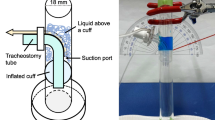Abstract
Purpose
Longitudinal folds in tracheal tube (TT) cuffs cause leakage of pooled secretions past the tube cuff, and the most common in vitro method to test the efficacy of a new tube is a benchtop model using an artificial rigid trachea. This study compared the potential of a static and dynamic ventilation benchtop model and cuff lubrication in testing the tracheal sealing properties of a given TT cuff.
Methods
Static trial Six brands of 7.5 mm internal diameter (ID) cuffed TT (n = 8) with high volume–low pressure cuffs were inflated in an artificial trachea (18 mm ID) without and with lubrication. Dynamic trial The same tube cuffs, without lubrication, were subjected to positive pressure ventilation (PPV) + positive end-expiratory pressure (PEEP) of 5cmH2O or to PPV alone (without PEEP) or to PEEP alone (without PPV). Clear water (5 ml) was placed above the tube cuff, and fluid leakage (ml) was measured up to 60 min.
Results
Gel lubrication, PEEP alone and PPV + PEEP completely prevented fluid leakage across the tube cuffs in all six TT brands tested within 60 min when compared to the static unlubricated model (0% leak versus 100% leak; P < 0.01). Fluid leakage in the static unlubricated model and the PPV group was 1.38–4.76 ml and 0.23–4.47 ml, respectively.
Conclusion
Gel lubrication, PEEP alone, and PPV + PEEP in the benchtop model had a much stronger protective effect than PPV alone on fluid leakage. Studies testing the fluid sealing efficiency of tube cuffs might be more conclusive in a static benchtop model without lubrication than in a dynamic model.




Similar content being viewed by others
References
Young PJ, Rollinson M, Downward G, Henderson S. Leakage of fluid past the tracheal tube cuff in a benchtop model. Br J Anaesth. 1997;78:557–62.
Oikkonen M, Aromaa U. Leakage of fluid around low-pressure tracheal tube cuffs. Anaesthesia. 1997;52:567–9.
Dullenkopf A, Gerber A, Weiss M. Fluid leakage past tracheal tube cuffs: evaluation of the new Microcuff endotracheal tube. Intensive Care Med. 2003;29:1849–53.
Seegobin RD, van Hasselt GL. Aspiration beyond endotracheal cuffs. Can Anaesth Soc J. 1986;33:273–9.
Young PJ, Ridley SA, Downward G. Evaluation of a new design of tracheal tube cuff to prevent leakage of fluid to the lungs. Br J Anaesth. 1998;80:796–9.
Asai T, Shingu K. Leakage of fluid around high-volume, low-pressure cuffs apparatus: a comparison of four tracheal tubes. Anaesthesia. 2001;56:38–42.
Zanella A, Cressoni M, Epp M, Stylianou M, Kolobow T. A double-layer tracheal tube cuff designed to prevent leakage: a bench-top study. Intensive Care Med. 2008;34:1145–9.
Young PJ, Blunt MC. Improving the shape and compliance characteristics of a high-volume, low-pressure cuff improves tracheal seal. Br J Anaesth. 1999;83:887–9.
Young PJ, Basson C, Hamilton D, Ridley SA. Prevention of tracheal aspiration using the pressure-limited tracheal tube cuff. Anaesthesia. 1999;54:559–63.
Poelaert J, Depuydt P, De Wolf A, Van de Velde S, Herck I, Blot S. Polyurethane cuffed endotracheal tubes to prevent early postoperative pneumonia after cardiac surgery: a pilot study. J Thorac Cardiovasc Surg. 2008;135:771–6.
Blunt MC, Young PJ, Patil A, Haddock A. Gel lubrication of the tracheal tube cuff reduces pulmonary aspiration. Anesthesiology. 2001;95:377–81.
Sanjay PS, Miller SA, Corry PR, Russell GN, Pennefather SH. The effect of gel lubrication on cuff leakage of double lumen tubes during thoracic surgery. Anaesthesia. 2006;61:133–7.
Lucangelo U, Zin WA, Antonaglia V, Petrucci L, Viviani M, Buscema G, Borelli M, Berlot G. Effect of positive expiratory pressure and type of tracheal cuff on the incidence of aspiration in mechanically ventilated patients in an intensive care unit. Crit Care Med. 2008;36:409–13.
Acknowledgment
This study was supported by departmental resources.
Conflict of interest statement
The tracheal tubes tested were ordered from local distributors. Prof. Weiss was involved in the development and evaluation of new cuffed paediatric tracheal tubes in cooperation with Microcuff GmbH, Weinheim, Germany and Covidien, Athlone, Ireland.
Author information
Authors and Affiliations
Corresponding author
About this article
Cite this article
Dave, M.H., Koepfer, N., Madjdpour, C. et al. Tracheal fluid leakage in benchtop trials: comparison of static versus dynamic ventilation model with and without lubrication. J Anesth 24, 247–252 (2010). https://doi.org/10.1007/s00540-010-0871-z
Received:
Accepted:
Published:
Issue Date:
DOI: https://doi.org/10.1007/s00540-010-0871-z




